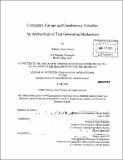| dc.contributor.advisor | William Charles Uricchio. | en_US |
| dc.contributor.author | Trettien, Whitney Anne | en_US |
| dc.contributor.other | Massachusetts Institute of Technology. Dept. of Comparative Media Studies. | en_US |
| dc.date.accessioned | 2010-04-28T15:43:38Z | |
| dc.date.available | 2010-04-28T15:43:38Z | |
| dc.date.copyright | 2009 | en_US |
| dc.date.issued | 2009 | en_US |
| dc.identifier.uri | http://hdl.handle.net/1721.1/54505 | |
| dc.description | Thesis (S.M.)--Massachusetts Institute of Technology, Dept. of Comparative Media Studies, 2009. | en_US |
| dc.description | Cataloged from PDF version of thesis. | en_US |
| dc.description.abstract | Through an archaeology of text-generating mechanisms, the present work excavates the deep history of reading and writing as material, combinatory practices. On the one hand, by positing the physical manipulation of language as a form of reading and writing, this archaeology answers Roger Chartier's call for book historians to "take on the task of retracing forgotten gestures and habits" that do not fit "the genealogy of our own contemporary manner of reading," a call echoed in much recent work on the "use" of early modem books. It thus challenges our assumptions about how readers and writers of the past made meaning from printed texts and, more broadly, the expressive potentials of the printed book itself. Yet this archaeology of ars combinatoria, the art of combination, also presents a imaginative challenge to historians of the book. For if we accept physically cutting paper or spinning a volvelle as a readerly and writerly act, then we must also erase the boundaries we have drawn between "the book" as a material form and "the digital" as an epistemology, reconsidering the various literacies each facilitates or forecloses. In keeping with the spirit of media archaeology, which seeks to defamiliarize the past, the present work on text-generating mechanisms exists as a web-based text-generating mechanism. On the one hand, this medium allows me to present a comparative history without compromising specificity or reducing the complexity of one moment to a mere reflection of another; yet it still strives for thematic cohesion by using our digital present quite literally as a map for exploring programmatic epistemologies in our past. It lives on the web at: http://www.whitneyannetrettien.com/thesis/ Since MIT Libraries requires a paper copy of a thesis, all HTML pages and code used to produce this thesis are copied in the space below. | en_US |
| dc.description.statementofresponsibility | by Whitney Anne Trettien. | en_US |
| dc.format.extent | 461 p. | en_US |
| dc.language.iso | eng | en_US |
| dc.publisher | Massachusetts Institute of Technology | en_US |
| dc.rights | M.I.T. theses are protected by
copyright. They may be viewed from this source for any purpose, but
reproduction or distribution in any format is prohibited without written
permission. See provided URL for inquiries about permission. | en_US |
| dc.rights.uri | http://dspace.mit.edu/handle/1721.1/7582 | en_US |
| dc.subject | Comparative Media Studies. | en_US |
| dc.title | Computers, cut-ups and combinatory volvelles : an archaeology of text-generating mechanisms | en_US |
| dc.title.alternative | Earth like a changing-wheel : seventeenth-century digital poetry | en_US |
| dc.title.alternative | Archaeology of text-generating mechanisms | en_US |
| dc.type | Thesis | en_US |
| dc.description.degree | S.M. | en_US |
| dc.identifier.oclc | 558730773 | en_US |
